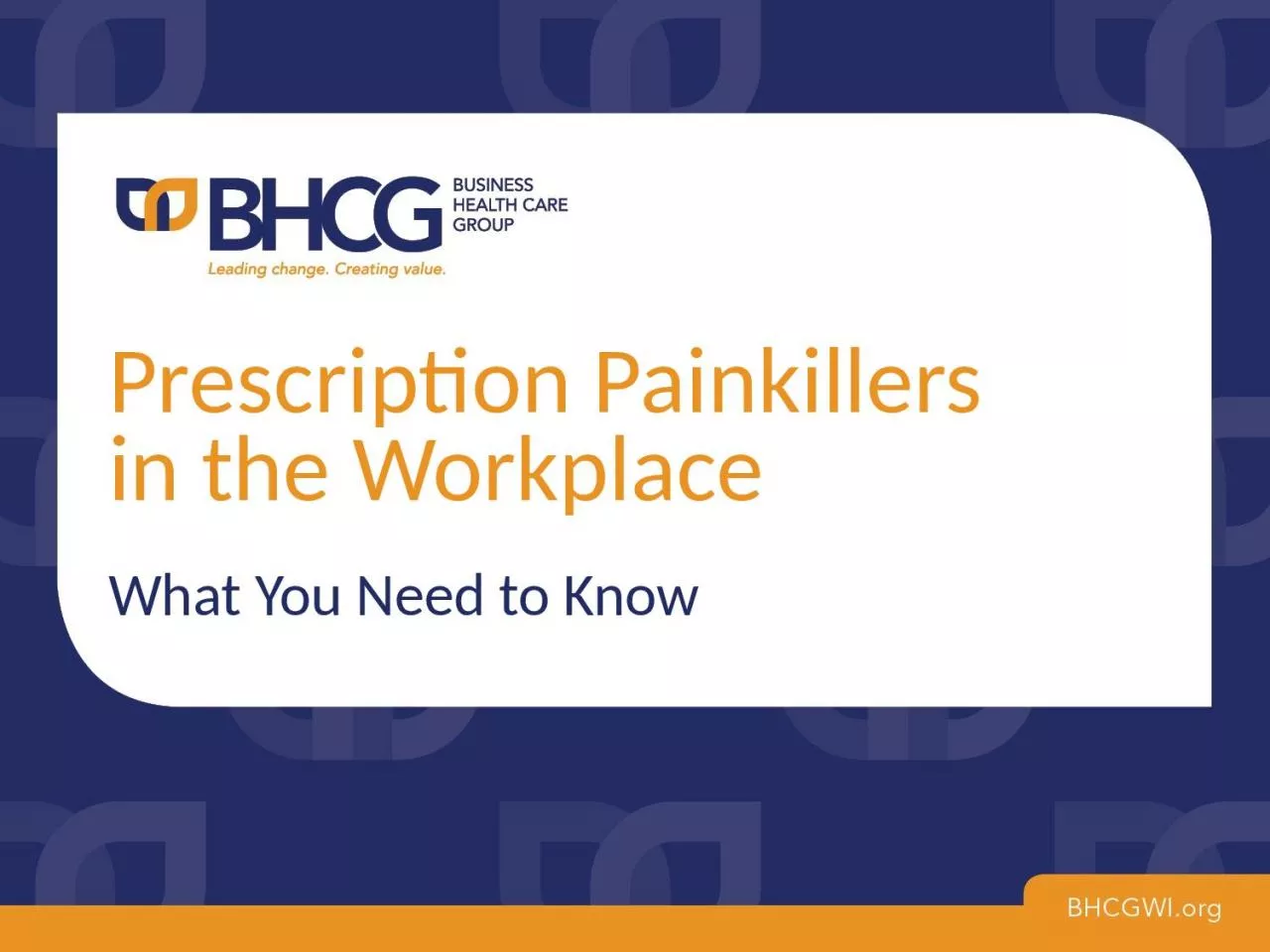

in the Workplace What You Need to Know Signs of Opioid Abuse What you should know Physical Signs of Opioid Abuse Unusual drowsinessnodding off at random times Dizziness Constricted small pupils ID: 934416
Download Presentation The PPT/PDF document "Prescription Painkillers" is the property of its rightful owner. Permission is granted to download and print the materials on this web site for personal, non-commercial use only, and to display it on your personal computer provided you do not modify the materials and that you retain all copyright notices contained in the materials. By downloading content from our website, you accept the terms of this agreement.
Slide1
Prescription Painkillers in the Workplace
What You Need to Know
Slide2Signs of Opioid Abuse
What you should know
Slide3Physical Signs of Opioid AbuseUnusual drowsiness/nodding off at random times
Dizziness
Constricted (small) pupils
Glassy eyes
Slowed breathing
Nausea
Constipation
Weight loss or decline of appearance
Slide4Behavioral Signs of Opioid AbuseExtreme mood swings
Irritability/angry outbursts
Anxiety
Euphoria
Confusion
Secrecy/dishonesty
More absences from work
Consistently late to work
Withdrawal from friends, coworkers and family
Change in friends
Neglecting responsibilities
Slide5Medication Warning Signs
Taking medications for
reasons other than
physical pain
Loss of control over
medication use
Taking medications
prescribed for
someone else
Slide6Opioid AbuseWhat can you do?
Slide7Suspect Opioid Abuse at Work?Tell a supervisor as soon as possible
(manager, security team or HR officer)
Confidential process
Do not be concerned you are risking a coworker’s job
You are reducing accident risk
You may be saving someone’s health/life
Slide8Do You or Someone You Know Need Help?UnitedHealthcare Substance Use Helpline:
855-780-5955
Available 24/7 for you or a family member
Substance Abuse and Mental Health Services Administration Treatment Services Locator
findtreatment.samhsa.gov
Contact our Employee Assistance Program (
EAP
)
xxx-xxx-
xxxx
or
info@ABCEAP.com
Confidentially contact Human Resources at
xxx-xxx-
xxxx
Slide9Common Types of Opioids & Narcotics
Slide10What Are Opioids?
Prescription-only drugs
–
treat and manage moderate to severe pain
Naturally found in the opium poppy plant
Also made in labs using same chemical structure
Relax the body and block pain signals sent from the brain to the body
Slide11Common Narcotic Pain Medications
Opioid/Narcotics:
Brand Name:
Oxycodone
OxyContin
®
, Percodan
®
, Percocet
®
Hydrocodone
Vicodin
®
, Lortab
®
,
Lorcet
®
Morphine
Kadian
®
,
Avinza
®
, MS
Contin
®
Codeine
Various Brand Names
Fentanyl
Duragesic
®
Propoxyphene
Darvon
®
Meperidine
Demerol
®
Methadone
Various Brand Names
Slide12Heroin
Made from morphine from opium poppy plants
White or brown powder or black sticky substance
Injected, sniffed, snorted or smoked
High risk of overdose or death
Increased risk due to high potency fentanyl added to heroin
Nearly 80% of Americans using heroin abused prescription opioids
Slide13If You Are Prescribed Opioid Painkillers
What to do
Slide14Did You Know?
Opioid painkillers can affect your ability to do your job
Opioid side effects
Drowziness
, dizziness, nausea
Driving under the influence
Even if painkillers are
legally prescribed,
you can still be cited
Slide15Talking With Your DoctorAsk questions if you are prescribed an opioid painkiller
Ask about safety
Inform them about:
Additional risk factors (genetics, family history, trauma, mental health, history of substance abuse, psychological/social stressors
Other medications and providers
Be honest about your concerns
Discuss alternatives
Slide16Alternative Pain Medication OptionsAlternative pain medications for opioids carry fewer risks and side effects
Always check with your doctor about taking alternatives
Over-the-counter medications
Ibuprofen (Advil), acetaminophen (Tylenol), naproxen (Aleve)
Prescription strength anti-inflammatory drugs
Celcoxib (Celbrex), diclofenac (Voltaren), etodolac (Lodine)
Slide17Alternative Pain Medication Options Select prescription non-opioids that target nerves
that produce pain
Gabapenin
(Neurontin), pregabalin (Lyrica)
Injectable and topical non-opioid therapies
Chiropractic services, physical and massage therapy,
exercise
, yoga
and cognitive behavioral therapy
Slide18If Painkillers Are Prescribed
Discuss your tasks
Talk with your supervisor before you perform safety sensitive tasks
Exercise caution
Driving, operating or working around machinery
Risk of serious injury or death
Inform:
Talk with your supervisor or
HR to let them know
Slide19Prescription Painkillers in the WorkplaceMore Information
XYZ’s Workplace Drug Policy
XYZ.com
/
humanresources
/
drugpolicy
Contact your manager/supervisor
Call HR at
xxx-xxx-
xxxx
, ext. x
Slide20CDC Guideline for Prescribing Opioids for Chronic Pain
What you should know
Slide21What is the CDC Guideline?Developed by the Centers for Disease Control and Prevention (CDC) developed for primary care clinicians treating adults for chronic pain in outpatient setting
Developed to:
Improve communication between clinicians and patients
Provide safer, more effective care for patients with chronic pain
Help reduce opioid abuse and overdose
Provides recommendations to clinicians about appropriate prescribing of opioids to improve pain management and patient safety
Slide22CDC Guideline – Patient Care & Safety
Nonopioid
therapy is preferred
for chronic pain (outside of cancer, palliative and end-of-life care):
The
lowest possible effective dosage
should be prescribed (to reduce abuse and overdose)
Clinicians should exercise caution
when prescribing opioids and monitor patients closely
Slide23CDC Guidelines – Before Starting Opioids
Make the most informed decision with your doctor
Learn about prescription opioids and the risks
Consider other ways to manage pain
Physical therapy
Exercise
Non-opioid medications (e.g., acetaminophen, ibuprofen)
Cognitive behavioral therapy (CBT)
Slide24Safe Prescription Opioid Storage & Disposal
Slide25Did You Know?
Misuse/giving prescription drugs someone other than
the prescribed can be:
Illegal
Potentially deadly
In 2015, the majority of opioid-related deaths involved prescription drugs
Flushed/drain-disposed Rx medications can contaminate
the water supply
More than 70% of people using prescription painkillers get them from family or friends
Slide26Safe Storage of Prescription Painkillers
Store out of reach of children
Keep secure and out of sight
Consider storing in a lockbox,
safe or locked medicine cabinet
Store Rx
painkillers
out of sight/preferably in
locked
drawer or cabinet
Slide27Safe Disposal of Prescription PainkillersNever flush or pour down the drain
Take unused prescription drugs to a collection program
or event
Wisconsin Department of Justice DRUG TAKE BACK days in spring and fall (some locations are permanent)
doseofrealitywi.gov/drug-takeback/find-a-take-back-location/
Local Police Departments (call to find out if they will accept)
Purchase mail-back packages from doctors, pharmacies, or police station